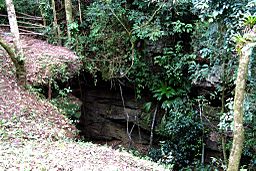Haitón del Guarataro facts for kids
The Haitón del Guarataro is a very deep solutional cave system. It is found in the Sierra de San Luis mountains in Falcón State, Venezuela. This amazing cave is about 2.5 kilometres (1.6 mi) south-east of a town called Curimagua.
It is the deepest limestone cave in Venezuela. The cave's entrance is a popular spot for tourists. It is part of the Juan Crisóstomo Falcón National Park.
Contents
What is the Haitón del Guarataro Cave?
A "solutional cave" means it was formed by water dissolving rock. This cave was made in Oligocene reefal limestone. Limestone is a type of rock that water can slowly eat away at. This process creates tunnels and large rooms over a very long time.
The cave has a huge entrance that is 12 metres (39 ft) wide. This entrance leads to several big drops. The first drop is 168 metres (551 ft) deep. After that, there are drops of 55 metres (180 ft) and 19 metres (62 ft).
Inside the Cave
These drops lead to a stream passage. This passage follows the slope of the rock for about 350 metres (1,150 ft) to the north. Eventually, it becomes blocked.
There is also an upstream passage. This part runs south for about 150 metres (490 ft) to the bottom of another shaft. The Haitón del Guarataro cave is 305 metres (1,001 ft) deep in total. All its passages together measure 640 metres (2,100 ft) long.
Exploring the Cave
The Haitón del Guarataro cave was first explored and mapped in April 1973. A group called the Venezuela '73 British Karst Research Expedition did this work. They were the first to go deep inside and draw maps of the cave's layout.
Cave Creatures
During the exploration, scientists also looked for animals living in the cave. They found a few types of "cavernicoles." These are creatures that live in caves.
Some of the animals they found included cave crickets. They also saw phalangodid harvestmen, which are like spiders. In a large pool of water, they found a pale shrimp called Hyalella meinerti. This shrimp had lost its color because it lives in the dark.
They also discovered a troglobitic trichopolydesmid millipede. This special millipede was found on the roof of the very last chamber of the cave. "Troglobitic" means it lives its whole life in the cave and cannot survive outside.
See also
 In Spanish: Haitón del Guarataro para niños
In Spanish: Haitón del Guarataro para niños


